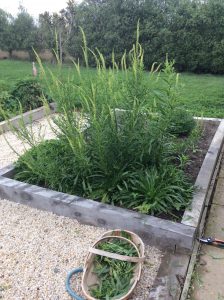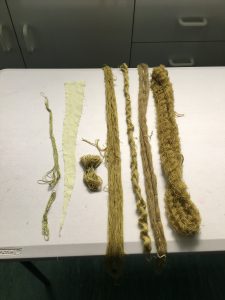Every third Sunday of the month, the Southron Gaard Fibre Guild members get together to share what we’re working on and to learn from each other. By popular request, at our March Fibre Guild get-together we had a go at some natural dyeing. And by popular request, I mean mostly requested by me as I’d never (intentionally) naturally dyed anything before.
Courtesy of Mistress Eleanora’s weld patch coming  ready for harvest, we had a large quantity of fresh weld for use. I learnt that weld was widely used to achieve a bright, reasonably colour-fast, yellow. The plant grows as smallish clumps with tall leafy stalks and small yellow flowers (see picture at right).
ready for harvest, we had a large quantity of fresh weld for use. I learnt that weld was widely used to achieve a bright, reasonably colour-fast, yellow. The plant grows as smallish clumps with tall leafy stalks and small yellow flowers (see picture at right).
For our have-a-go, Mistress Eleanora prepared approximately 2 litres of dyestuff ahead of time, so we started our day at the mordanting stage. A typical ratio of dyestuff to material is 100 – 200%, and we only had a very small amount of fabric (53g), so this meant we had a very strong dye-bath.
Members had brought a variety of fibre to demonstrate dyeing on: linen cloth, silk thread, alpaca yarn, commercially-produced wool yarn and homespun wool yarn. The fibre was first soaked in tap-hot water, and then prepared by mordanting – soaking the fibre in a solution which opens it up and allows dyestuff to be better absorbed. For our mordanting, we used 5g (10% of fibre weight) of alum and 2g (5% of fibre weight) of cream of tartar. This was brought to the boil and the fibre then simmered in it for 1 hour.
The fibre was then transferred to the hot dye pot and simmered again for 1 hour. After this the fibre was rinsed in tap-hot water, and again in slightly cooler water. This, I learned, is to avoid ‘shocking’ the fibres.
The end results were interesting, not just for a first-time dyer like me, but also for those more experienced dyers present. The dye came out more green than yellow on the fibre (see picture below). This apparently could have been due to the very strong dyebath, but there were other possible factors mooted e.g. freshness of the weld.

From left to right:
- Silk thread x 2
- Linen fabric
- Wool
- Commercially spun wool
- Hand spun wool
- Hand spun alpaca (was originally a warm beige)
- Hand spun wool (over-spun)
An educational day, and I look forward to trying more dyeing in the near future. (And also doing battle with my brewing better half for “most offensive smells produced in the kitchen”.)
Lady Adrienne Furet
